Applied Social Research: Qualitative, Quantitative, and Ethics Essay
VerifiedAdded on 2023/01/10
|11
|2509
|55
Essay
AI Summary
This essay provides a critical analysis of a research proposal investigating indigenous mental health strategies. It begins with an overview of qualitative and quantitative research methodologies, discussing their respective strengths and weaknesses, with a focus on semi-structured interviews and thematic analysis. The essay then analyzes the research proposal, evaluating the chosen methodologies and their suitability for the research objectives. A significant portion is dedicated to assessing the ethical integrity of the proposed research, considering the "NHMRC National Statement on Ethical Conduct in Human Research" and the "Ethical Guidelines" for Aboriginal and Torres Strait Islander Peoples. The analysis highlights the importance of ethical considerations, including informed consent, confidentiality, and cultural sensitivity. Finally, the essay suggests ways to strengthen the research proposal, focusing on providing more detailed information and seeking necessary approvals. The conclusion summarizes the key findings and reinforces the importance of ethical and methodologically sound research in the context of indigenous mental health.

Essay
Paraphrase This Document
Need a fresh take? Get an instant paraphrase of this document with our AI Paraphraser
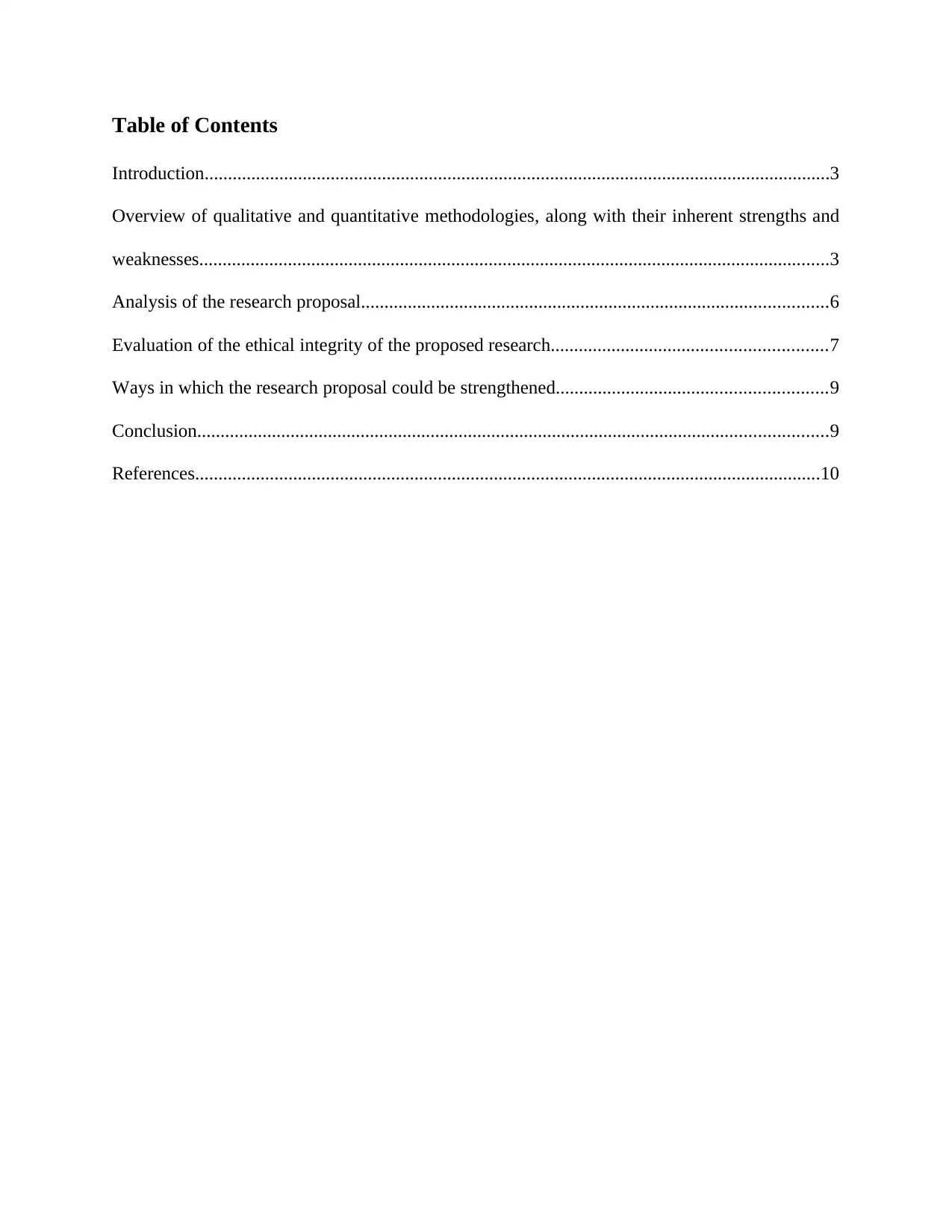
Table of Contents
Introduction......................................................................................................................................3
Overview of qualitative and quantitative methodologies, along with their inherent strengths and
weaknesses.......................................................................................................................................3
Analysis of the research proposal....................................................................................................6
Evaluation of the ethical integrity of the proposed research...........................................................7
Ways in which the research proposal could be strengthened..........................................................9
Conclusion.......................................................................................................................................9
References......................................................................................................................................10
Introduction......................................................................................................................................3
Overview of qualitative and quantitative methodologies, along with their inherent strengths and
weaknesses.......................................................................................................................................3
Analysis of the research proposal....................................................................................................6
Evaluation of the ethical integrity of the proposed research...........................................................7
Ways in which the research proposal could be strengthened..........................................................9
Conclusion.......................................................................................................................................9
References......................................................................................................................................10
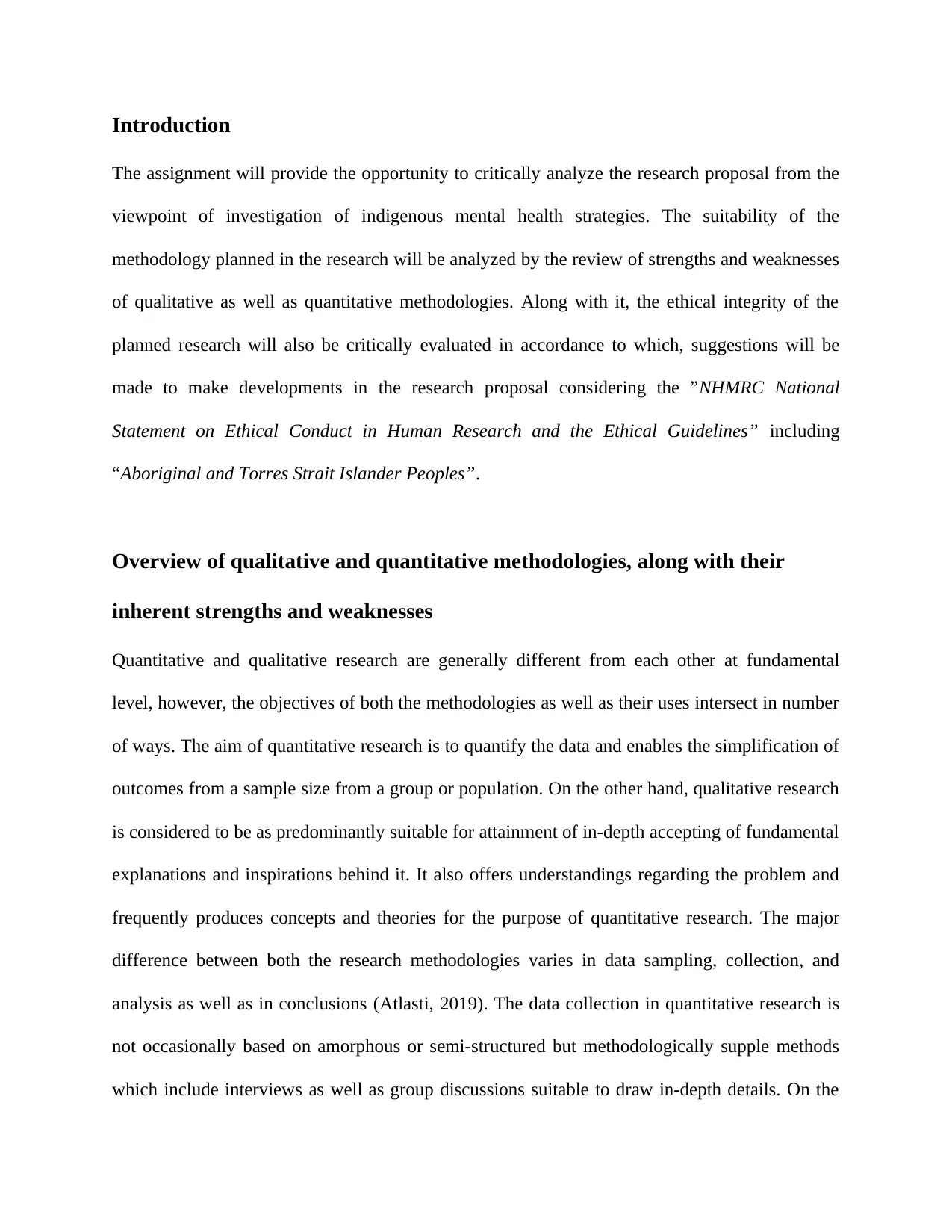
Introduction
The assignment will provide the opportunity to critically analyze the research proposal from the
viewpoint of investigation of indigenous mental health strategies. The suitability of the
methodology planned in the research will be analyzed by the review of strengths and weaknesses
of qualitative as well as quantitative methodologies. Along with it, the ethical integrity of the
planned research will also be critically evaluated in accordance to which, suggestions will be
made to make developments in the research proposal considering the ”NHMRC National
Statement on Ethical Conduct in Human Research and the Ethical Guidelines” including
“Aboriginal and Torres Strait Islander Peoples”.
Overview of qualitative and quantitative methodologies, along with their
inherent strengths and weaknesses
Quantitative and qualitative research are generally different from each other at fundamental
level, however, the objectives of both the methodologies as well as their uses intersect in number
of ways. The aim of quantitative research is to quantify the data and enables the simplification of
outcomes from a sample size from a group or population. On the other hand, qualitative research
is considered to be as predominantly suitable for attainment of in-depth accepting of fundamental
explanations and inspirations behind it. It also offers understandings regarding the problem and
frequently produces concepts and theories for the purpose of quantitative research. The major
difference between both the research methodologies varies in data sampling, collection, and
analysis as well as in conclusions (Atlasti, 2019). The data collection in quantitative research is
not occasionally based on amorphous or semi-structured but methodologically supple methods
which include interviews as well as group discussions suitable to draw in-depth details. On the
The assignment will provide the opportunity to critically analyze the research proposal from the
viewpoint of investigation of indigenous mental health strategies. The suitability of the
methodology planned in the research will be analyzed by the review of strengths and weaknesses
of qualitative as well as quantitative methodologies. Along with it, the ethical integrity of the
planned research will also be critically evaluated in accordance to which, suggestions will be
made to make developments in the research proposal considering the ”NHMRC National
Statement on Ethical Conduct in Human Research and the Ethical Guidelines” including
“Aboriginal and Torres Strait Islander Peoples”.
Overview of qualitative and quantitative methodologies, along with their
inherent strengths and weaknesses
Quantitative and qualitative research are generally different from each other at fundamental
level, however, the objectives of both the methodologies as well as their uses intersect in number
of ways. The aim of quantitative research is to quantify the data and enables the simplification of
outcomes from a sample size from a group or population. On the other hand, qualitative research
is considered to be as predominantly suitable for attainment of in-depth accepting of fundamental
explanations and inspirations behind it. It also offers understandings regarding the problem and
frequently produces concepts and theories for the purpose of quantitative research. The major
difference between both the research methodologies varies in data sampling, collection, and
analysis as well as in conclusions (Atlasti, 2019). The data collection in quantitative research is
not occasionally based on amorphous or semi-structured but methodologically supple methods
which include interviews as well as group discussions suitable to draw in-depth details. On the
⊘ This is a preview!⊘
Do you want full access?
Subscribe today to unlock all pages.

Trusted by 1+ million students worldwide
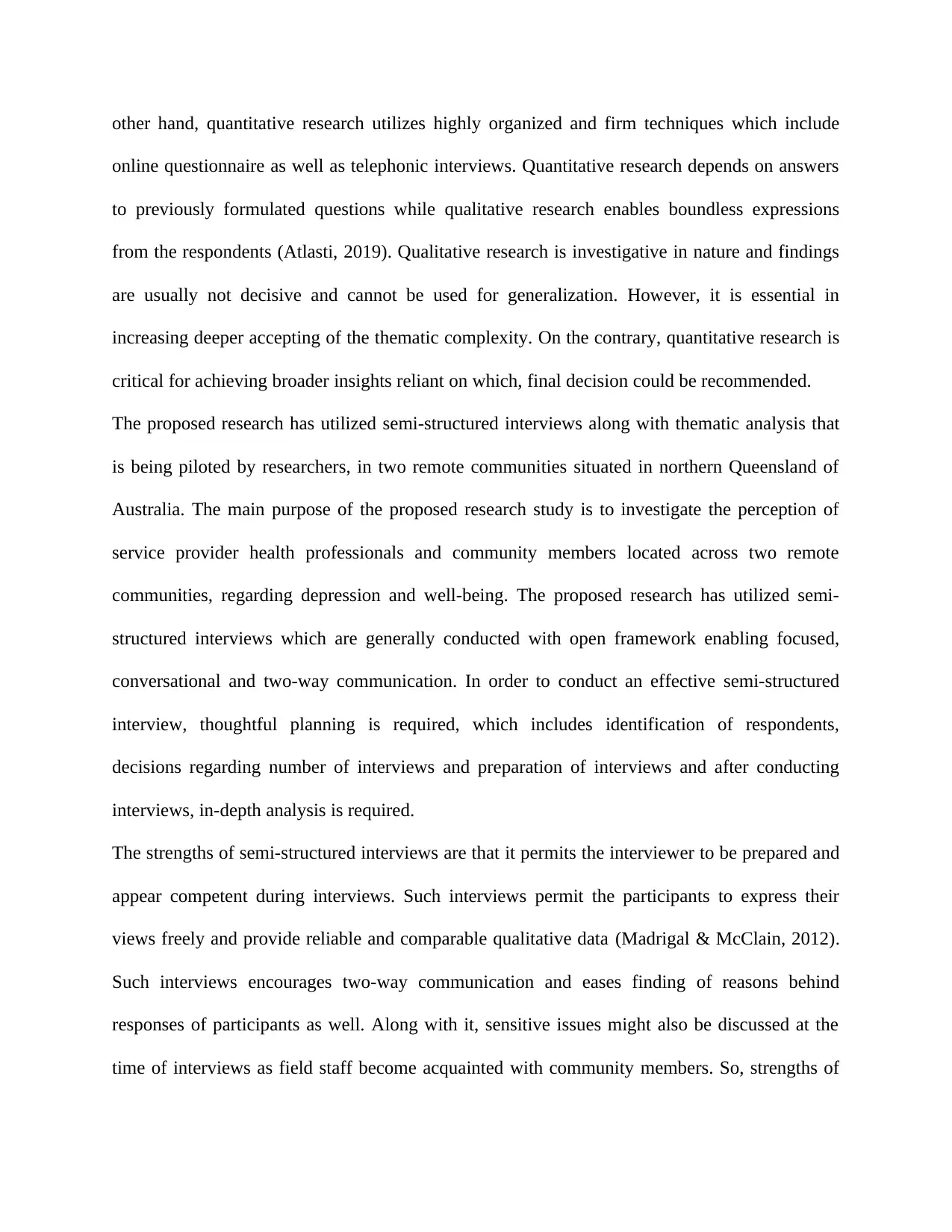
other hand, quantitative research utilizes highly organized and firm techniques which include
online questionnaire as well as telephonic interviews. Quantitative research depends on answers
to previously formulated questions while qualitative research enables boundless expressions
from the respondents (Atlasti, 2019). Qualitative research is investigative in nature and findings
are usually not decisive and cannot be used for generalization. However, it is essential in
increasing deeper accepting of the thematic complexity. On the contrary, quantitative research is
critical for achieving broader insights reliant on which, final decision could be recommended.
The proposed research has utilized semi-structured interviews along with thematic analysis that
is being piloted by researchers, in two remote communities situated in northern Queensland of
Australia. The main purpose of the proposed research study is to investigate the perception of
service provider health professionals and community members located across two remote
communities, regarding depression and well-being. The proposed research has utilized semi-
structured interviews which are generally conducted with open framework enabling focused,
conversational and two-way communication. In order to conduct an effective semi-structured
interview, thoughtful planning is required, which includes identification of respondents,
decisions regarding number of interviews and preparation of interviews and after conducting
interviews, in-depth analysis is required.
The strengths of semi-structured interviews are that it permits the interviewer to be prepared and
appear competent during interviews. Such interviews permit the participants to express their
views freely and provide reliable and comparable qualitative data (Madrigal & McClain, 2012).
Such interviews encourages two-way communication and eases finding of reasons behind
responses of participants as well. Along with it, sensitive issues might also be discussed at the
time of interviews as field staff become acquainted with community members. So, strengths of
online questionnaire as well as telephonic interviews. Quantitative research depends on answers
to previously formulated questions while qualitative research enables boundless expressions
from the respondents (Atlasti, 2019). Qualitative research is investigative in nature and findings
are usually not decisive and cannot be used for generalization. However, it is essential in
increasing deeper accepting of the thematic complexity. On the contrary, quantitative research is
critical for achieving broader insights reliant on which, final decision could be recommended.
The proposed research has utilized semi-structured interviews along with thematic analysis that
is being piloted by researchers, in two remote communities situated in northern Queensland of
Australia. The main purpose of the proposed research study is to investigate the perception of
service provider health professionals and community members located across two remote
communities, regarding depression and well-being. The proposed research has utilized semi-
structured interviews which are generally conducted with open framework enabling focused,
conversational and two-way communication. In order to conduct an effective semi-structured
interview, thoughtful planning is required, which includes identification of respondents,
decisions regarding number of interviews and preparation of interviews and after conducting
interviews, in-depth analysis is required.
The strengths of semi-structured interviews are that it permits the interviewer to be prepared and
appear competent during interviews. Such interviews permit the participants to express their
views freely and provide reliable and comparable qualitative data (Madrigal & McClain, 2012).
Such interviews encourages two-way communication and eases finding of reasons behind
responses of participants as well. Along with it, sensitive issues might also be discussed at the
time of interviews as field staff become acquainted with community members. So, strengths of
Paraphrase This Document
Need a fresh take? Get an instant paraphrase of this document with our AI Paraphraser
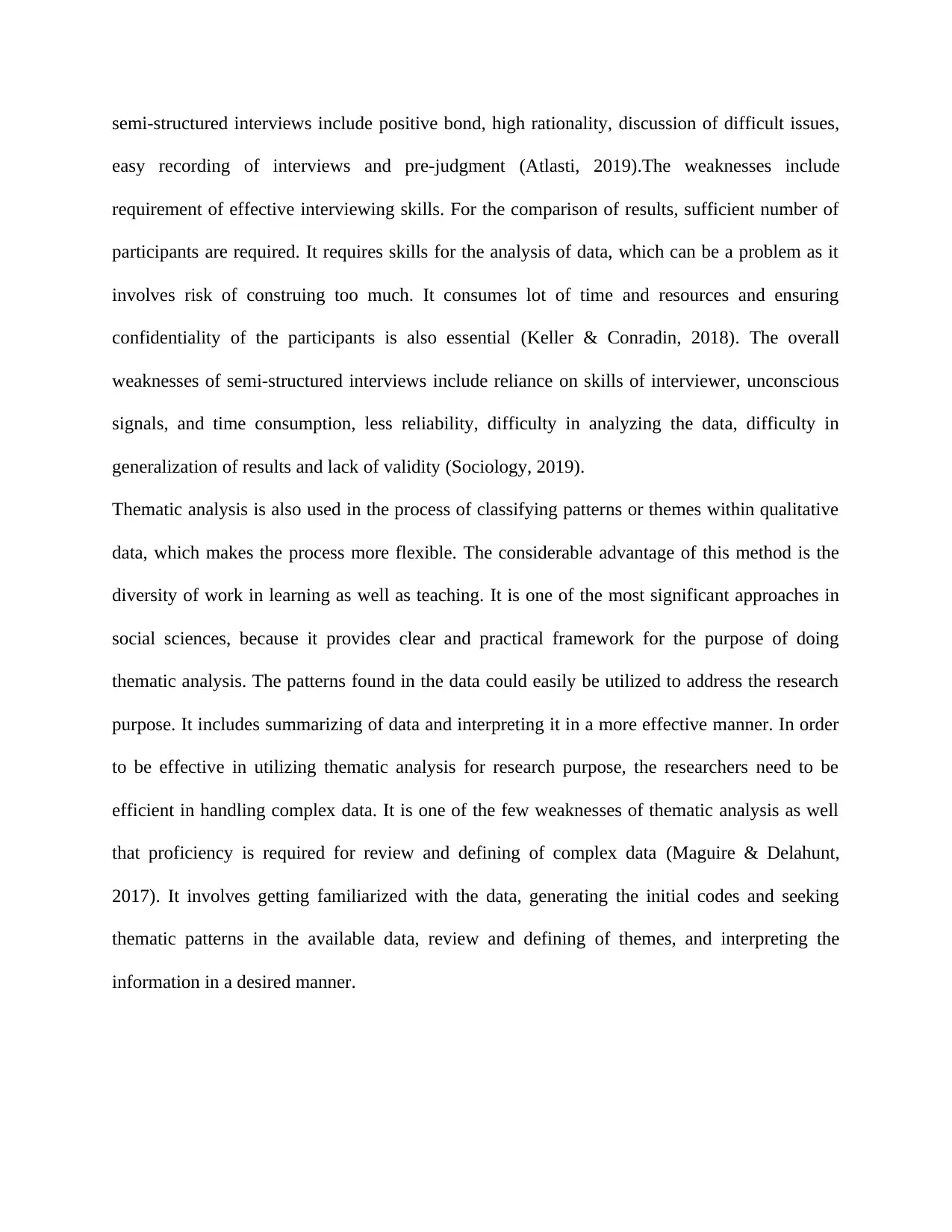
semi-structured interviews include positive bond, high rationality, discussion of difficult issues,
easy recording of interviews and pre-judgment (Atlasti, 2019).The weaknesses include
requirement of effective interviewing skills. For the comparison of results, sufficient number of
participants are required. It requires skills for the analysis of data, which can be a problem as it
involves risk of construing too much. It consumes lot of time and resources and ensuring
confidentiality of the participants is also essential (Keller & Conradin, 2018). The overall
weaknesses of semi-structured interviews include reliance on skills of interviewer, unconscious
signals, and time consumption, less reliability, difficulty in analyzing the data, difficulty in
generalization of results and lack of validity (Sociology, 2019).
Thematic analysis is also used in the process of classifying patterns or themes within qualitative
data, which makes the process more flexible. The considerable advantage of this method is the
diversity of work in learning as well as teaching. It is one of the most significant approaches in
social sciences, because it provides clear and practical framework for the purpose of doing
thematic analysis. The patterns found in the data could easily be utilized to address the research
purpose. It includes summarizing of data and interpreting it in a more effective manner. In order
to be effective in utilizing thematic analysis for research purpose, the researchers need to be
efficient in handling complex data. It is one of the few weaknesses of thematic analysis as well
that proficiency is required for review and defining of complex data (Maguire & Delahunt,
2017). It involves getting familiarized with the data, generating the initial codes and seeking
thematic patterns in the available data, review and defining of themes, and interpreting the
information in a desired manner.
easy recording of interviews and pre-judgment (Atlasti, 2019).The weaknesses include
requirement of effective interviewing skills. For the comparison of results, sufficient number of
participants are required. It requires skills for the analysis of data, which can be a problem as it
involves risk of construing too much. It consumes lot of time and resources and ensuring
confidentiality of the participants is also essential (Keller & Conradin, 2018). The overall
weaknesses of semi-structured interviews include reliance on skills of interviewer, unconscious
signals, and time consumption, less reliability, difficulty in analyzing the data, difficulty in
generalization of results and lack of validity (Sociology, 2019).
Thematic analysis is also used in the process of classifying patterns or themes within qualitative
data, which makes the process more flexible. The considerable advantage of this method is the
diversity of work in learning as well as teaching. It is one of the most significant approaches in
social sciences, because it provides clear and practical framework for the purpose of doing
thematic analysis. The patterns found in the data could easily be utilized to address the research
purpose. It includes summarizing of data and interpreting it in a more effective manner. In order
to be effective in utilizing thematic analysis for research purpose, the researchers need to be
efficient in handling complex data. It is one of the few weaknesses of thematic analysis as well
that proficiency is required for review and defining of complex data (Maguire & Delahunt,
2017). It involves getting familiarized with the data, generating the initial codes and seeking
thematic patterns in the available data, review and defining of themes, and interpreting the
information in a desired manner.
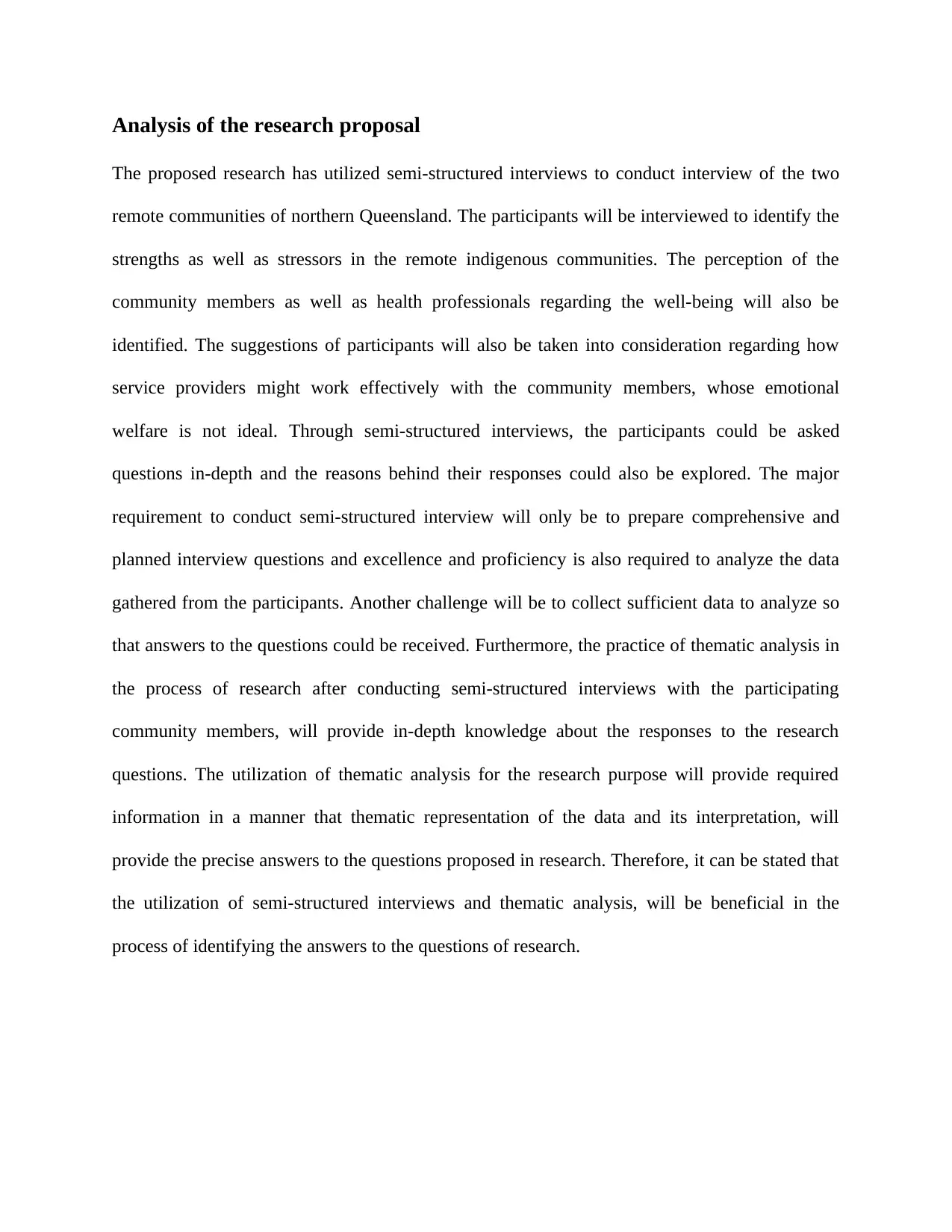
Analysis of the research proposal
The proposed research has utilized semi-structured interviews to conduct interview of the two
remote communities of northern Queensland. The participants will be interviewed to identify the
strengths as well as stressors in the remote indigenous communities. The perception of the
community members as well as health professionals regarding the well-being will also be
identified. The suggestions of participants will also be taken into consideration regarding how
service providers might work effectively with the community members, whose emotional
welfare is not ideal. Through semi-structured interviews, the participants could be asked
questions in-depth and the reasons behind their responses could also be explored. The major
requirement to conduct semi-structured interview will only be to prepare comprehensive and
planned interview questions and excellence and proficiency is also required to analyze the data
gathered from the participants. Another challenge will be to collect sufficient data to analyze so
that answers to the questions could be received. Furthermore, the practice of thematic analysis in
the process of research after conducting semi-structured interviews with the participating
community members, will provide in-depth knowledge about the responses to the research
questions. The utilization of thematic analysis for the research purpose will provide required
information in a manner that thematic representation of the data and its interpretation, will
provide the precise answers to the questions proposed in research. Therefore, it can be stated that
the utilization of semi-structured interviews and thematic analysis, will be beneficial in the
process of identifying the answers to the questions of research.
The proposed research has utilized semi-structured interviews to conduct interview of the two
remote communities of northern Queensland. The participants will be interviewed to identify the
strengths as well as stressors in the remote indigenous communities. The perception of the
community members as well as health professionals regarding the well-being will also be
identified. The suggestions of participants will also be taken into consideration regarding how
service providers might work effectively with the community members, whose emotional
welfare is not ideal. Through semi-structured interviews, the participants could be asked
questions in-depth and the reasons behind their responses could also be explored. The major
requirement to conduct semi-structured interview will only be to prepare comprehensive and
planned interview questions and excellence and proficiency is also required to analyze the data
gathered from the participants. Another challenge will be to collect sufficient data to analyze so
that answers to the questions could be received. Furthermore, the practice of thematic analysis in
the process of research after conducting semi-structured interviews with the participating
community members, will provide in-depth knowledge about the responses to the research
questions. The utilization of thematic analysis for the research purpose will provide required
information in a manner that thematic representation of the data and its interpretation, will
provide the precise answers to the questions proposed in research. Therefore, it can be stated that
the utilization of semi-structured interviews and thematic analysis, will be beneficial in the
process of identifying the answers to the questions of research.
⊘ This is a preview!⊘
Do you want full access?
Subscribe today to unlock all pages.

Trusted by 1+ million students worldwide
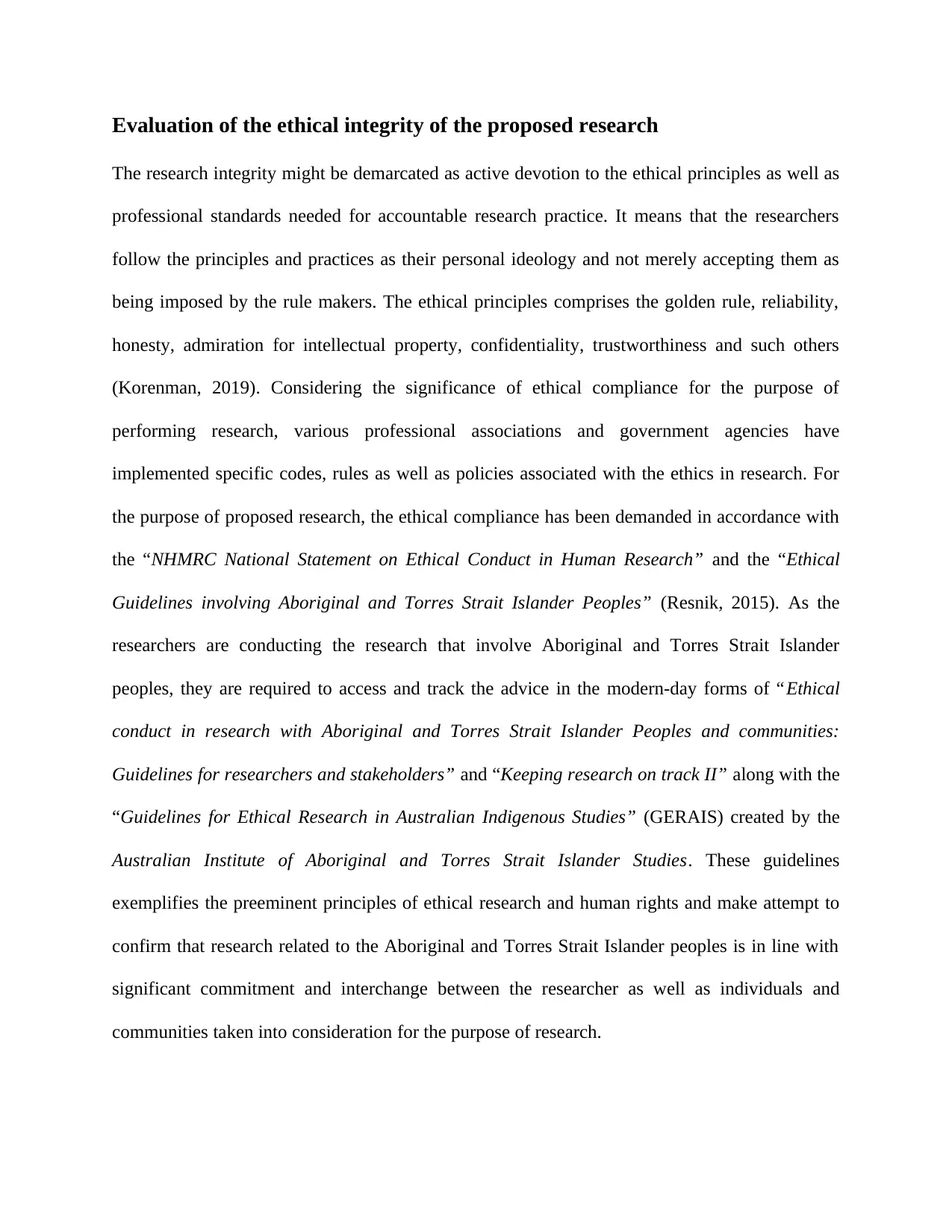
Evaluation of the ethical integrity of the proposed research
The research integrity might be demarcated as active devotion to the ethical principles as well as
professional standards needed for accountable research practice. It means that the researchers
follow the principles and practices as their personal ideology and not merely accepting them as
being imposed by the rule makers. The ethical principles comprises the golden rule, reliability,
honesty, admiration for intellectual property, confidentiality, trustworthiness and such others
(Korenman, 2019). Considering the significance of ethical compliance for the purpose of
performing research, various professional associations and government agencies have
implemented specific codes, rules as well as policies associated with the ethics in research. For
the purpose of proposed research, the ethical compliance has been demanded in accordance with
the “NHMRC National Statement on Ethical Conduct in Human Research” and the “Ethical
Guidelines involving Aboriginal and Torres Strait Islander Peoples” (Resnik, 2015). As the
researchers are conducting the research that involve Aboriginal and Torres Strait Islander
peoples, they are required to access and track the advice in the modern-day forms of “Ethical
conduct in research with Aboriginal and Torres Strait Islander Peoples and communities:
Guidelines for researchers and stakeholders” and “Keeping research on track II” along with the
“Guidelines for Ethical Research in Australian Indigenous Studies” (GERAIS) created by the
Australian Institute of Aboriginal and Torres Strait Islander Studies. These guidelines
exemplifies the preeminent principles of ethical research and human rights and make attempt to
confirm that research related to the Aboriginal and Torres Strait Islander peoples is in line with
significant commitment and interchange between the researcher as well as individuals and
communities taken into consideration for the purpose of research.
The research integrity might be demarcated as active devotion to the ethical principles as well as
professional standards needed for accountable research practice. It means that the researchers
follow the principles and practices as their personal ideology and not merely accepting them as
being imposed by the rule makers. The ethical principles comprises the golden rule, reliability,
honesty, admiration for intellectual property, confidentiality, trustworthiness and such others
(Korenman, 2019). Considering the significance of ethical compliance for the purpose of
performing research, various professional associations and government agencies have
implemented specific codes, rules as well as policies associated with the ethics in research. For
the purpose of proposed research, the ethical compliance has been demanded in accordance with
the “NHMRC National Statement on Ethical Conduct in Human Research” and the “Ethical
Guidelines involving Aboriginal and Torres Strait Islander Peoples” (Resnik, 2015). As the
researchers are conducting the research that involve Aboriginal and Torres Strait Islander
peoples, they are required to access and track the advice in the modern-day forms of “Ethical
conduct in research with Aboriginal and Torres Strait Islander Peoples and communities:
Guidelines for researchers and stakeholders” and “Keeping research on track II” along with the
“Guidelines for Ethical Research in Australian Indigenous Studies” (GERAIS) created by the
Australian Institute of Aboriginal and Torres Strait Islander Studies. These guidelines
exemplifies the preeminent principles of ethical research and human rights and make attempt to
confirm that research related to the Aboriginal and Torres Strait Islander peoples is in line with
significant commitment and interchange between the researcher as well as individuals and
communities taken into consideration for the purpose of research.
Paraphrase This Document
Need a fresh take? Get an instant paraphrase of this document with our AI Paraphraser
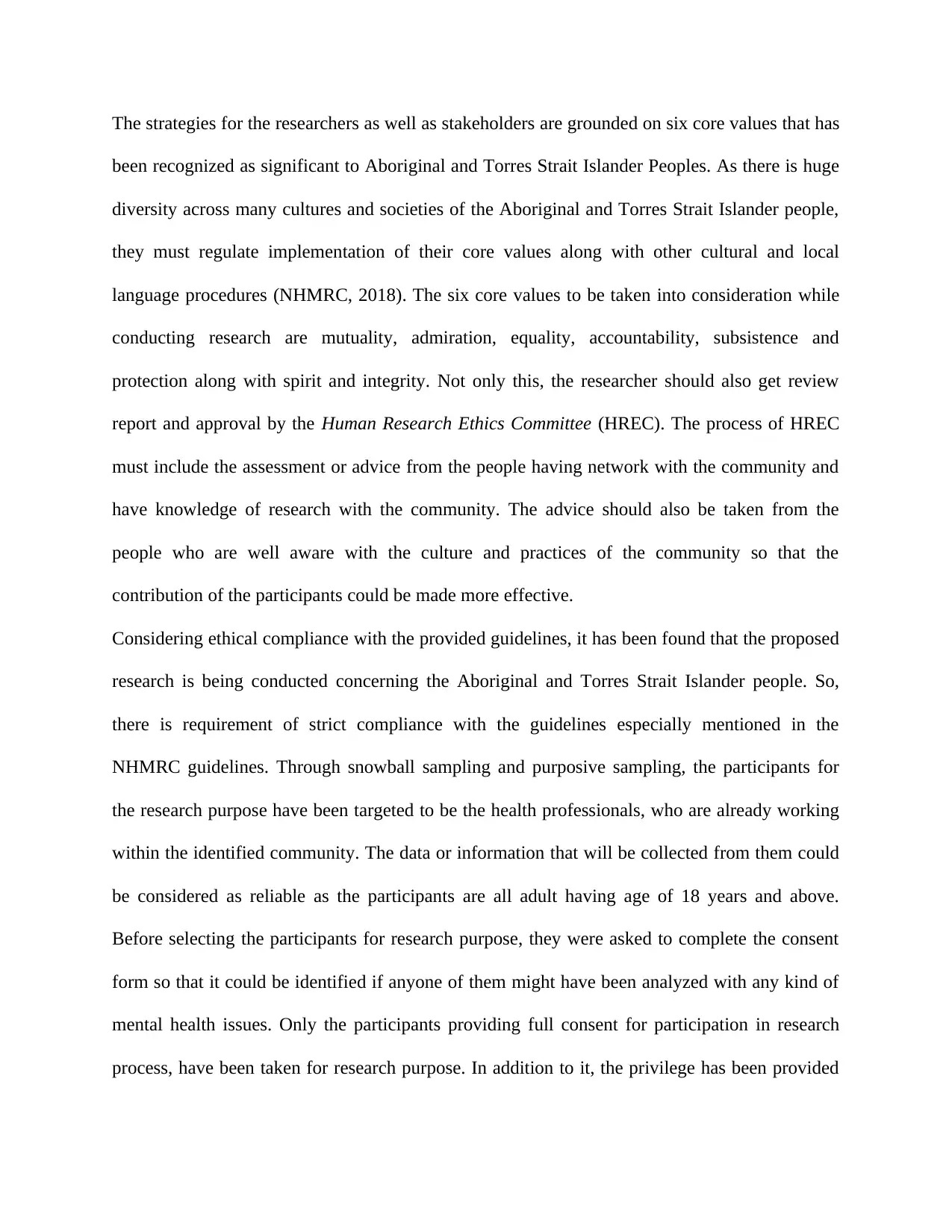
The strategies for the researchers as well as stakeholders are grounded on six core values that has
been recognized as significant to Aboriginal and Torres Strait Islander Peoples. As there is huge
diversity across many cultures and societies of the Aboriginal and Torres Strait Islander people,
they must regulate implementation of their core values along with other cultural and local
language procedures (NHMRC, 2018). The six core values to be taken into consideration while
conducting research are mutuality, admiration, equality, accountability, subsistence and
protection along with spirit and integrity. Not only this, the researcher should also get review
report and approval by the Human Research Ethics Committee (HREC). The process of HREC
must include the assessment or advice from the people having network with the community and
have knowledge of research with the community. The advice should also be taken from the
people who are well aware with the culture and practices of the community so that the
contribution of the participants could be made more effective.
Considering ethical compliance with the provided guidelines, it has been found that the proposed
research is being conducted concerning the Aboriginal and Torres Strait Islander people. So,
there is requirement of strict compliance with the guidelines especially mentioned in the
NHMRC guidelines. Through snowball sampling and purposive sampling, the participants for
the research purpose have been targeted to be the health professionals, who are already working
within the identified community. The data or information that will be collected from them could
be considered as reliable as the participants are all adult having age of 18 years and above.
Before selecting the participants for research purpose, they were asked to complete the consent
form so that it could be identified if anyone of them might have been analyzed with any kind of
mental health issues. Only the participants providing full consent for participation in research
process, have been taken for research purpose. In addition to it, the privilege has been provided
been recognized as significant to Aboriginal and Torres Strait Islander Peoples. As there is huge
diversity across many cultures and societies of the Aboriginal and Torres Strait Islander people,
they must regulate implementation of their core values along with other cultural and local
language procedures (NHMRC, 2018). The six core values to be taken into consideration while
conducting research are mutuality, admiration, equality, accountability, subsistence and
protection along with spirit and integrity. Not only this, the researcher should also get review
report and approval by the Human Research Ethics Committee (HREC). The process of HREC
must include the assessment or advice from the people having network with the community and
have knowledge of research with the community. The advice should also be taken from the
people who are well aware with the culture and practices of the community so that the
contribution of the participants could be made more effective.
Considering ethical compliance with the provided guidelines, it has been found that the proposed
research is being conducted concerning the Aboriginal and Torres Strait Islander people. So,
there is requirement of strict compliance with the guidelines especially mentioned in the
NHMRC guidelines. Through snowball sampling and purposive sampling, the participants for
the research purpose have been targeted to be the health professionals, who are already working
within the identified community. The data or information that will be collected from them could
be considered as reliable as the participants are all adult having age of 18 years and above.
Before selecting the participants for research purpose, they were asked to complete the consent
form so that it could be identified if anyone of them might have been analyzed with any kind of
mental health issues. Only the participants providing full consent for participation in research
process, have been taken for research purpose. In addition to it, the privilege has been provided
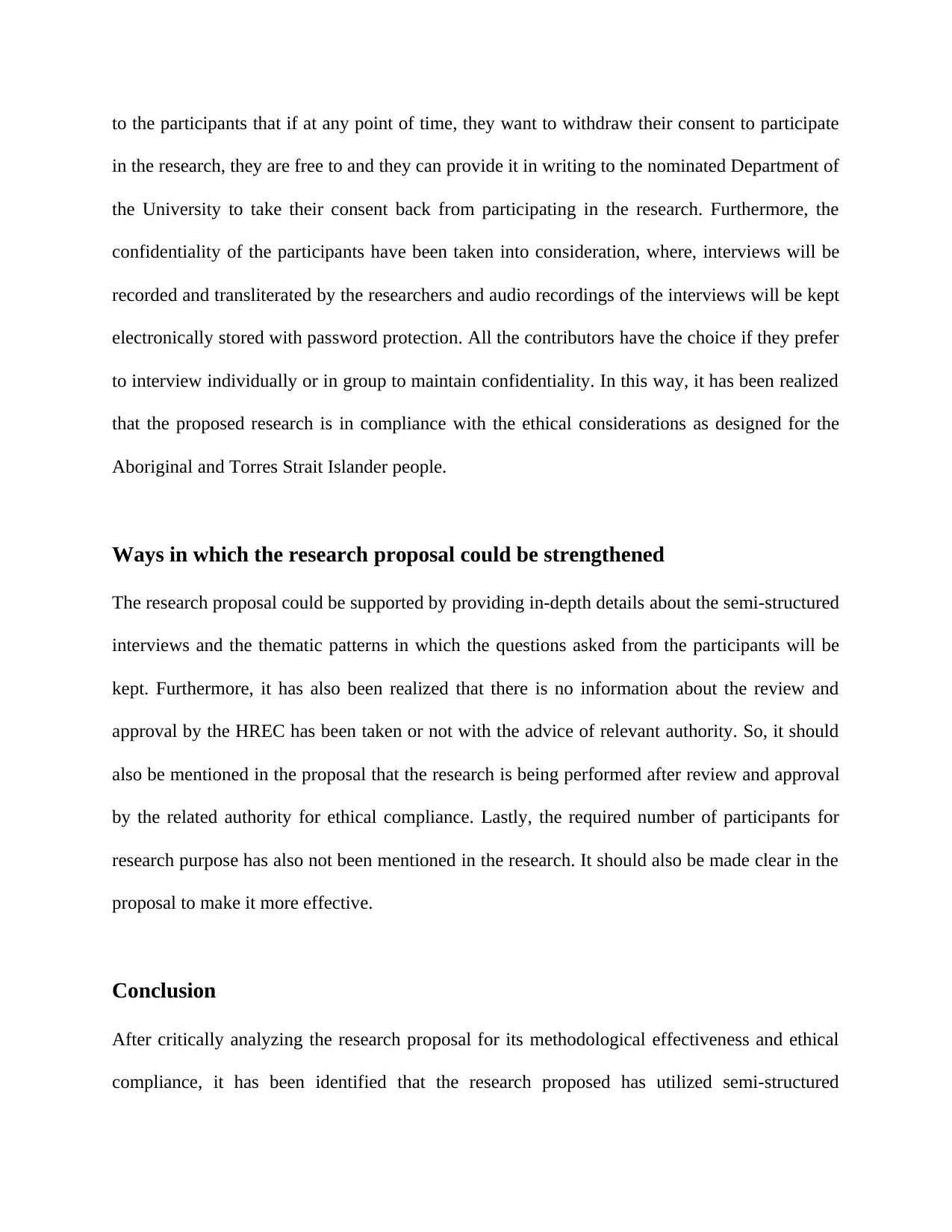
to the participants that if at any point of time, they want to withdraw their consent to participate
in the research, they are free to and they can provide it in writing to the nominated Department of
the University to take their consent back from participating in the research. Furthermore, the
confidentiality of the participants have been taken into consideration, where, interviews will be
recorded and transliterated by the researchers and audio recordings of the interviews will be kept
electronically stored with password protection. All the contributors have the choice if they prefer
to interview individually or in group to maintain confidentiality. In this way, it has been realized
that the proposed research is in compliance with the ethical considerations as designed for the
Aboriginal and Torres Strait Islander people.
Ways in which the research proposal could be strengthened
The research proposal could be supported by providing in-depth details about the semi-structured
interviews and the thematic patterns in which the questions asked from the participants will be
kept. Furthermore, it has also been realized that there is no information about the review and
approval by the HREC has been taken or not with the advice of relevant authority. So, it should
also be mentioned in the proposal that the research is being performed after review and approval
by the related authority for ethical compliance. Lastly, the required number of participants for
research purpose has also not been mentioned in the research. It should also be made clear in the
proposal to make it more effective.
Conclusion
After critically analyzing the research proposal for its methodological effectiveness and ethical
compliance, it has been identified that the research proposed has utilized semi-structured
in the research, they are free to and they can provide it in writing to the nominated Department of
the University to take their consent back from participating in the research. Furthermore, the
confidentiality of the participants have been taken into consideration, where, interviews will be
recorded and transliterated by the researchers and audio recordings of the interviews will be kept
electronically stored with password protection. All the contributors have the choice if they prefer
to interview individually or in group to maintain confidentiality. In this way, it has been realized
that the proposed research is in compliance with the ethical considerations as designed for the
Aboriginal and Torres Strait Islander people.
Ways in which the research proposal could be strengthened
The research proposal could be supported by providing in-depth details about the semi-structured
interviews and the thematic patterns in which the questions asked from the participants will be
kept. Furthermore, it has also been realized that there is no information about the review and
approval by the HREC has been taken or not with the advice of relevant authority. So, it should
also be mentioned in the proposal that the research is being performed after review and approval
by the related authority for ethical compliance. Lastly, the required number of participants for
research purpose has also not been mentioned in the research. It should also be made clear in the
proposal to make it more effective.
Conclusion
After critically analyzing the research proposal for its methodological effectiveness and ethical
compliance, it has been identified that the research proposed has utilized semi-structured
⊘ This is a preview!⊘
Do you want full access?
Subscribe today to unlock all pages.

Trusted by 1+ million students worldwide
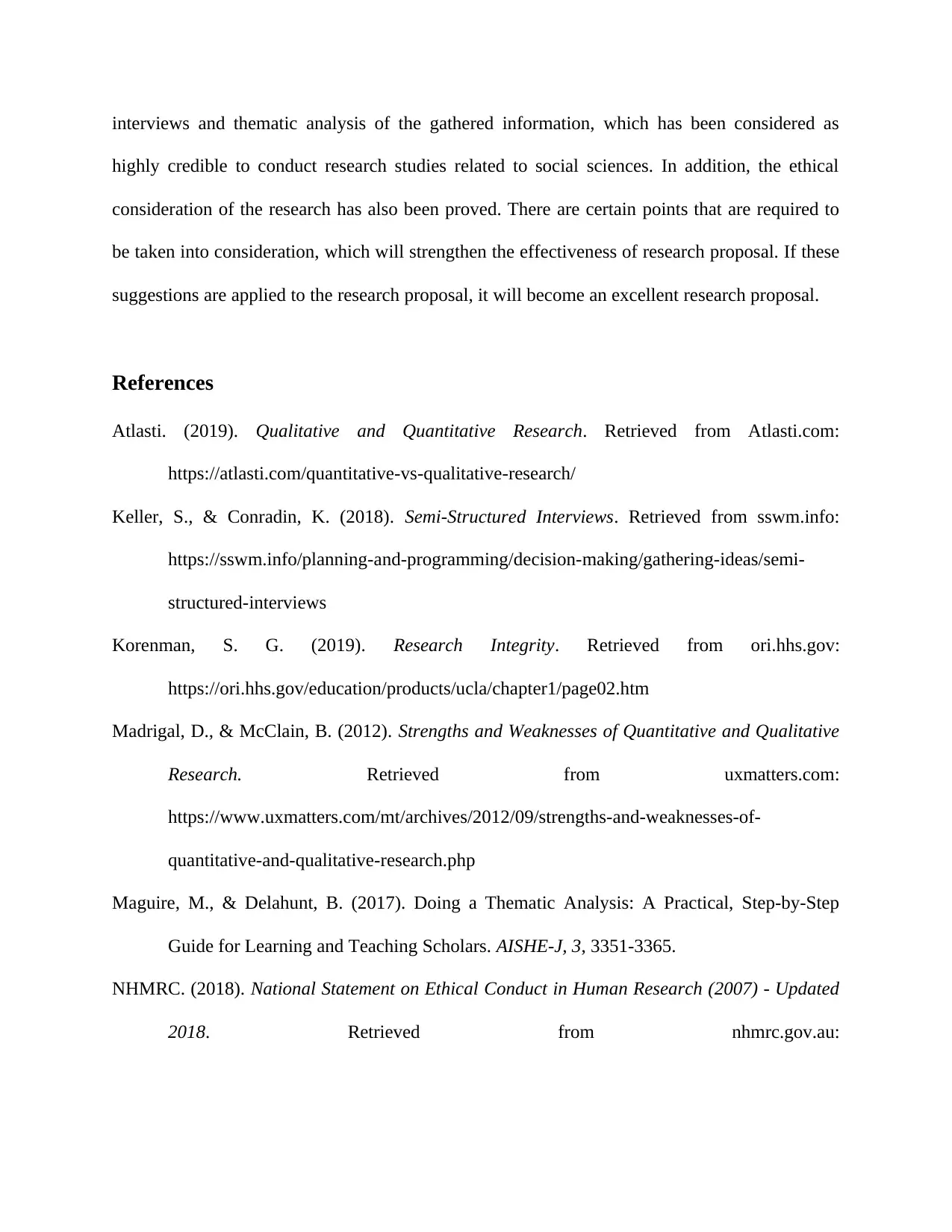
interviews and thematic analysis of the gathered information, which has been considered as
highly credible to conduct research studies related to social sciences. In addition, the ethical
consideration of the research has also been proved. There are certain points that are required to
be taken into consideration, which will strengthen the effectiveness of research proposal. If these
suggestions are applied to the research proposal, it will become an excellent research proposal.
References
Atlasti. (2019). Qualitative and Quantitative Research. Retrieved from Atlasti.com:
https://atlasti.com/quantitative-vs-qualitative-research/
Keller, S., & Conradin, K. (2018). Semi-Structured Interviews. Retrieved from sswm.info:
https://sswm.info/planning-and-programming/decision-making/gathering-ideas/semi-
structured-interviews
Korenman, S. G. (2019). Research Integrity. Retrieved from ori.hhs.gov:
https://ori.hhs.gov/education/products/ucla/chapter1/page02.htm
Madrigal, D., & McClain, B. (2012). Strengths and Weaknesses of Quantitative and Qualitative
Research. Retrieved from uxmatters.com:
https://www.uxmatters.com/mt/archives/2012/09/strengths-and-weaknesses-of-
quantitative-and-qualitative-research.php
Maguire, M., & Delahunt, B. (2017). Doing a Thematic Analysis: A Practical, Step-by-Step
Guide for Learning and Teaching Scholars. AISHE-J, 3, 3351-3365.
NHMRC. (2018). National Statement on Ethical Conduct in Human Research (2007) - Updated
2018. Retrieved from nhmrc.gov.au:
highly credible to conduct research studies related to social sciences. In addition, the ethical
consideration of the research has also been proved. There are certain points that are required to
be taken into consideration, which will strengthen the effectiveness of research proposal. If these
suggestions are applied to the research proposal, it will become an excellent research proposal.
References
Atlasti. (2019). Qualitative and Quantitative Research. Retrieved from Atlasti.com:
https://atlasti.com/quantitative-vs-qualitative-research/
Keller, S., & Conradin, K. (2018). Semi-Structured Interviews. Retrieved from sswm.info:
https://sswm.info/planning-and-programming/decision-making/gathering-ideas/semi-
structured-interviews
Korenman, S. G. (2019). Research Integrity. Retrieved from ori.hhs.gov:
https://ori.hhs.gov/education/products/ucla/chapter1/page02.htm
Madrigal, D., & McClain, B. (2012). Strengths and Weaknesses of Quantitative and Qualitative
Research. Retrieved from uxmatters.com:
https://www.uxmatters.com/mt/archives/2012/09/strengths-and-weaknesses-of-
quantitative-and-qualitative-research.php
Maguire, M., & Delahunt, B. (2017). Doing a Thematic Analysis: A Practical, Step-by-Step
Guide for Learning and Teaching Scholars. AISHE-J, 3, 3351-3365.
NHMRC. (2018). National Statement on Ethical Conduct in Human Research (2007) - Updated
2018. Retrieved from nhmrc.gov.au:
Paraphrase This Document
Need a fresh take? Get an instant paraphrase of this document with our AI Paraphraser
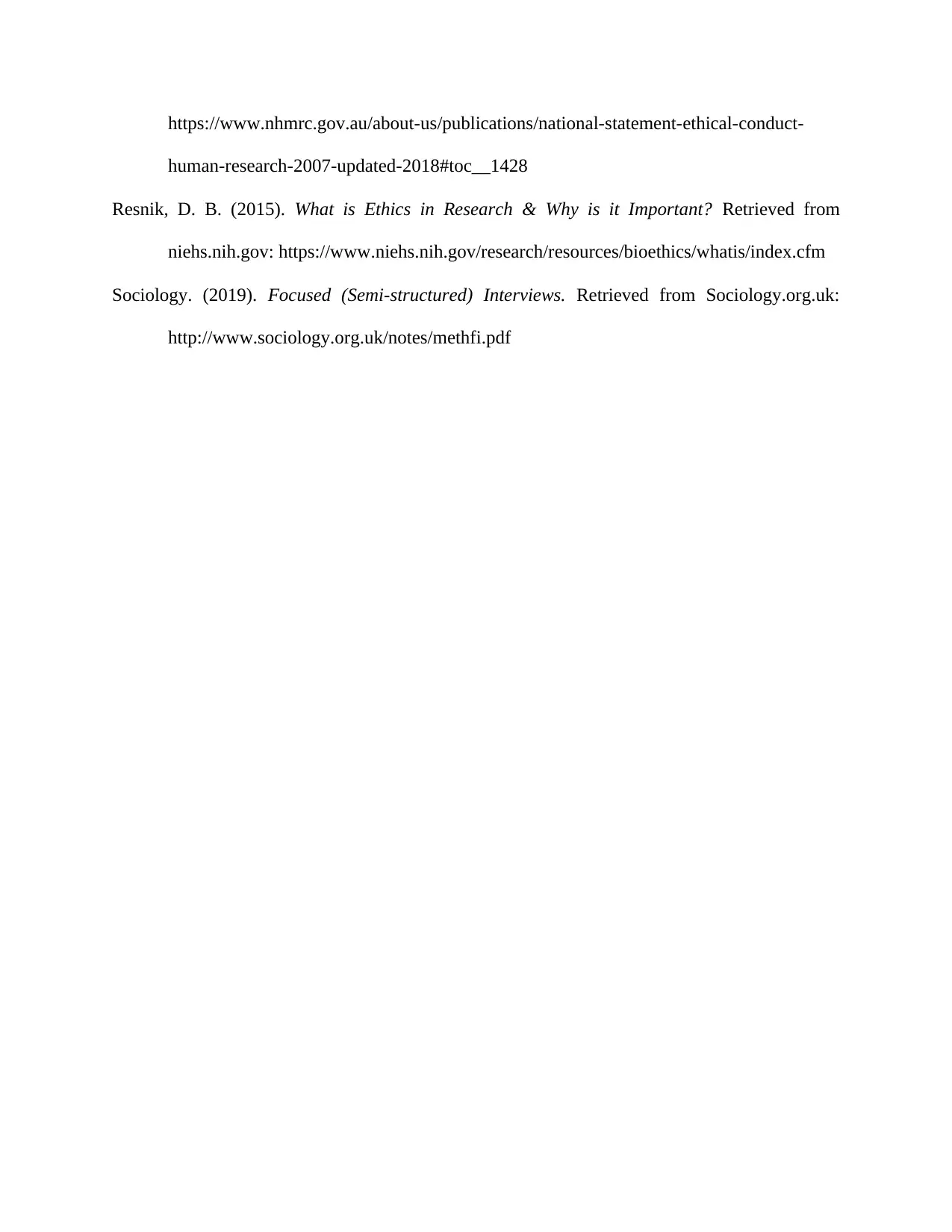
https://www.nhmrc.gov.au/about-us/publications/national-statement-ethical-conduct-
human-research-2007-updated-2018#toc__1428
Resnik, D. B. (2015). What is Ethics in Research & Why is it Important? Retrieved from
niehs.nih.gov: https://www.niehs.nih.gov/research/resources/bioethics/whatis/index.cfm
Sociology. (2019). Focused (Semi-structured) Interviews. Retrieved from Sociology.org.uk:
http://www.sociology.org.uk/notes/methfi.pdf
human-research-2007-updated-2018#toc__1428
Resnik, D. B. (2015). What is Ethics in Research & Why is it Important? Retrieved from
niehs.nih.gov: https://www.niehs.nih.gov/research/resources/bioethics/whatis/index.cfm
Sociology. (2019). Focused (Semi-structured) Interviews. Retrieved from Sociology.org.uk:
http://www.sociology.org.uk/notes/methfi.pdf
1 out of 11
Related Documents
Your All-in-One AI-Powered Toolkit for Academic Success.
+13062052269
info@desklib.com
Available 24*7 on WhatsApp / Email
![[object Object]](/_next/static/media/star-bottom.7253800d.svg)
Unlock your academic potential
Copyright © 2020–2025 A2Z Services. All Rights Reserved. Developed and managed by ZUCOL.




